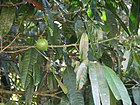Note: This is a project under development. The articles on this wiki are just being initiated and broadly incomplete. You can Help creating new pages.
Difference between revisions of "Garcinia xanthochymus"
(→Uses) |
|||
| Line 2: | Line 2: | ||
'''Garcinia xanthochymus''' is an evergreen tree with more or less horizontal branches and a dense pyramidal crown. It can grow 8 - 15 metres tall. It has a short, straight bole. The tree is harvested from the wild, and is also cultivated and semi-cultivated, for its edible fruit and dyestuff. | '''Garcinia xanthochymus''' is an evergreen tree with more or less horizontal branches and a dense pyramidal crown. It can grow 8 - 15 metres tall. It has a short, straight bole. The tree is harvested from the wild, and is also cultivated and semi-cultivated, for its edible fruit and dyestuff. | ||
==Uses== | ==Uses== | ||
| − | + | {{Uses|}}, {{Uses|}}, {{Uses|}}.<ref name="Uses"/> | |
==Parts Used== | ==Parts Used== | ||
Revision as of 16:19, 11 May 2020
Garcinia xanthochymus is an evergreen tree with more or less horizontal branches and a dense pyramidal crown. It can grow 8 - 15 metres tall. It has a short, straight bole. The tree is harvested from the wild, and is also cultivated and semi-cultivated, for its edible fruit and dyestuff.
Contents
- 1 Uses
- 2 Parts Used
- 3 Chemical Composition
- 4 Common names
- 5 Properties
- 6 Habit
- 7 Identification
- 8 List of Ayurvedic medicine in which the herb is used
- 9 Where to get the saplings
- 10 Mode of Propagation
- 11 How to plant/cultivate
- 12 Commonly seen growing in areas
- 13 Photo Gallery
- 14 References
- 15 External Links
Uses
[[:Category:Ayurvedic Herbs known to be helpful to treat |]], [[:Category:Ayurvedic Herbs known to be helpful to treat |]], [[:Category:Ayurvedic Herbs known to be helpful to treat |]].[1]
Parts Used
[[:Category:Herbs with used in medicine|]], stem, leaves, Root.
Chemical Composition
Common names
| Language | Common name |
|---|---|
| Kannada | Devajarige |
| Hindi | Jharambi |
| Malayalam | Anavaya |
| Tamil | Paccilai |
| Telugu | Cikatimranu |
| Marathi | |
| Gujarathi | |
| Punjabi | |
| Kashmiri | |
| Sanskrit | Bhavishya |
| English | Mysore Gamboge, Sour mangosteen |
Properties
Reference: Dravya - Substance, Rasa - Taste, Guna - Qualities, Veerya - Potency, Vipaka - Post-digesion effect, Karma - Pharmacological activity, Prabhava - Therepeutics.
Dravya
Rasa
Guna
Veerya
Vipaka
Karma
Prabhava
Habit
Identification
Leaf
| Kind | Shape | Feature |
|---|---|---|
Flower
| Type | Size | Color and composition | Stamen | More information |
|---|---|---|---|---|
| {{{5}}} |
Fruit
| Type | Size | Mass | Appearance | Seeds | More information |
|---|---|---|---|---|---|
Other features
List of Ayurvedic medicine in which the herb is used
Where to get the saplings
Mode of Propagation
How to plant/cultivate
A plant of the hot, humid tropics, where it is found at elevations up to 1,000 metres.[4]
Commonly seen growing in areas
Dense humid forests, On hills.
Photo Gallery
References
- ↑ Indian Medicinal Plants by C.P.Khare
- ↑ [Chemistry]
- ↑ [Morphology]
- ↑ Cultivation
External Links
- Ayurvedic Herbs known to be helpful to treat
- Herbs with used in medicine
- Herbs with stem used in medicine
- Herbs with leaves used in medicine
- Herbs with Root used in medicine
- Herbs with common name in Kannada
- Herbs with common name in Hindi
- Herbs with common name in Malayalam
- Herbs with common name in Tamil
- Herbs with common name in Telugu
- Herbs with common name in Sanskrit
- Herbs with common name in English
- Habit - Evergreen tree
- Index of Plants which can be propagated by Seeds
- Herbs that are commonly seen in the region of Dense humid forests
- Herbs that are commonly seen in the region of On hills
- Herbs
- Pages without herbs images





